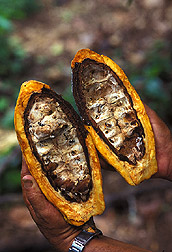Fungal Threats to Cocoa Share an Ancient History
|
|
A love of chocolate must run in the family—at least when it comes to freeloading fungi living on cocoa-bearing cacao trees.
Witches’ broom, caused by the fungus Crinipellis perniciosa, and frosty pod rot, triggered by Moniliophthora roreri, are costly burdens for the mainly small growers cultivating the world’s supply of cocoa beans in Central and South America.
Cathie Aime, a molecular biologist at ARS’s Systematic Botany and Mycology Laboratory in Beltsville, Maryland, has seen the pathogens’ damage firsthand.
“Crinipellis lives inside the tree’s branches,” she says, “causing it to send out these crazy shoots—or ‘brooms.’ Eventually the fungus emerges as pinkish-colored mushrooms. Frosty pod looks more like a cottony covering on the cocoa pods and doesn’t produce any known fruiting body.”
Despite the fungi’s apparent physical differences, Aime, in collaboration with Wilbert Phillips-Mora of CATIE, Costa Rica, has confirmed what others in her field have long suspected—that the two pathogens are actually closely related fungi.
Aime’s research built on work done by mycologist Harry Evans of CABI Bioscience in the United Kingdom. “In 1981, Evans proposed that the two pathogens might be closely related, and similarities in disease symptomology had been noted as early as 1918,” she says. “But at the time, the molecular tools needed to confirm the relationship didn’t exist.”
For her research, Aime was able to tap a previous body of work she’d contributed to—a study at Duke University that determined interrelationships and family groups of nearly 900 different species. The organisms all belonged to the order Agaricales, which contains about 350 genera, including the genus Crinipellis. Mushroom-forming fungi are referred to as “agarics.”
Aime sequenced genes from the two cacao pathogens, relating the data to sequences gained from the Agaricales project. Her comparisons revealed that frosty pod is also an agaric, despite the fact that it doesn’t form a mushroom-type fruiting body. In addition, further DNA analysis of five genes in total provided detailed evidence pointing to a close, sister-species relationship between the two pathogens.
“It’s speculation, but the fungi probably evolved from the same ancestor in or near the South American Andes,” Aime explains. “This earlier fungus may have started out as an endophyte, a fungus that lives inside its host plant without causing any harm. Then somewhere in its evolutionary past, that fungus went from harmless to parasitic and evolved into the two species we see today—witches’ broom and frosty pod rot.”
An Identity Crisis
Aime’s next challenge is deciding on the best way to reclassify the two fungi. “They don’t belong in the genus Crinipellis,” she says, “but rather in a brand-new one. I have to determine what the name of that genus will be.”
She wants to be certain of the name she’ll propose, since changes to scientific names are often slow to catch on. And it’s not the first time that either pathogen has been repositioned in the fungal family tree.
“In the 1940s, the witches’ broom pathogen was moved from the genus Marasmius to Crinipellis,” she says, “and it took more than 25 years for that name to stick.”
But the taxonomic shakeup brings some good news: “Because the two fungi are related,” Aime says, “biocontrol methods now used to keep witches’ broom in check may also work for frosty pod.”—By Erin K. Peabody, Agricultural Research Service Information Staff.
This research is part of Plant Diseases, an ARS National Program (#303) described on the World Wide Web at www.nps.ars.usda.gov.
Mary Catherine Aime is with the USDA-ARS Systematic Botany and Mycology Laboratory, 10300 Baltimore Ave., Bldg. 011A, Beltsville, MD 20705-2350; phone (301) 504-5758, fax (301) 504-5810.
"Fungal Threats to Cocoa Share an Ancient History" was published in the October 2005 issue of Agricultural Research magazine.








